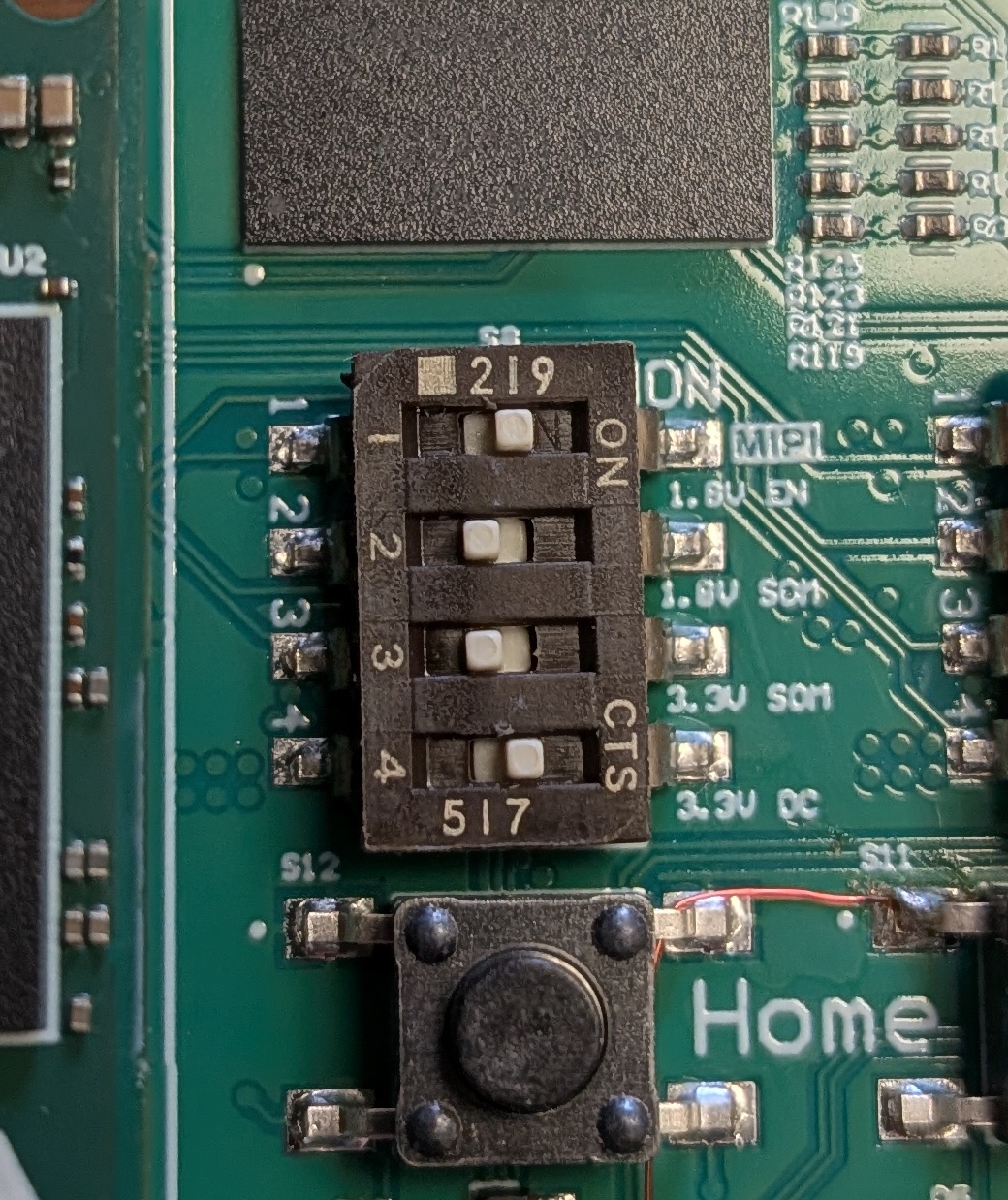MIPI Cameras¶
The MitySOM-QC6490 Devkit supports image and video capture via the MIPI CSI interfaces ( Note that currently CSI0 is the only MIPI CSI interface supported. Support for CSI1-CSI4 will be added in a future software release).
Note that currently CSI0 is the only MIPI CSI interface supported. Support for CSI1-CSI4 will be added in a future software release).
Development Board Configuration¶
Ensure that Switch S8 is set properly.- Switch 1 should be set to enable MIPI, which is a top level enable for 1.8 V for the MIPI interface
- Switch 2 can be either set or not set
- If Switch 2 is not set the 1.8V comes from the DC supply on the Development Kit
- If Switch 2 is set the 1.8V comes from the SOM
- Switch 3 should NOT be set for Rev 1 or 2 of the Development Board as 3.3V from the SOM may actually be a higher volage. See MitySOM-QC6490 Development Kit Datasheet for further details
- Switch 4 should be set to enable the 3V3 CSI from the DC supply

Note that the connector on the Development Board is a Hirose FH12A-22S-0.5SH(55) (22 pin 0.5 mm pitch).
Also note that when installing the cable the dark brown latch on the connector should be up and the cable should be inserted between the dark brown latch and light brown body with the pins on the cable facing up. Once the cable is in position the dark brown latch should be pushed down to secure the cable.
Please see the picture below for an example of a properly connected cable:

Known Working Cameras¶
The Waveshare OV9281-120 Mono Camera was used to validate the MIPI CSI interface. Note that this module has a 15 pin 1.0 mm pitch interface and you will need to acquire a 15 pin 1.0 mm pitch to 22 pin 0.5 mm pitch adapter cable in order to use this module on the Development Board.
Capturing Single Images¶
- Ensure the qcom-multimedia-image has been flashed onto the MitySOM-QC6490.
- You can verify which image you are working with via the following command:
root@qcs6490-mitysom-devkit:~# cat /etc/buildinfo | grep IMAGE_BASENAME IMAGE_BASENAME = qcom-multimedia-image
- You can verify which image you are working with via the following command:
- The following Gstreamer pipeline will allow you to capture a single JPEG image:
gst-launch-1.0 qtiqmmfsrc camera=0 exposure-mode=0 manual-exposure-time=1333333 ! jpegenc snapshot=true ! identity error-after=2 ! filesink location=snap.jpg
- Note that this pipeline uses manual exposure. The value after manual-exposure-time= is the exposure time in nanoseconds.
- Further details on the qtiqmmfsrc Qualcomm GStreamer plugin and what properties are supported can be found here
Capturing Video¶
- Ensure the qcom-multimedia-image has been flashed onto the MitySOM-QC6490.
- You can verify which image you are working with via the following command:
root@qcs6490-mitysom-devkit:~# cat /etc/buildinfo | grep IMAGE_BASENAME IMAGE_BASENAME = qcom-multimedia-image
- You can verify which image you are working with via the following command:
- The following Gstreamer pipeline will allow you to capture an MP4 encoded video:
gst-launch-1.0 -e qtiqmmfsrc name=camsrc camera=0 ! \ video/x-raw,format=NV12,width=1280,height=720,framerate=30/1,\ interlace-mode=progressive,colorimetry=bt601 ! v4l2h264enc \ capture-io-mode=4 output-io-mode=5 extra-controls="controls,video_bitrate=6000000,\ video_bitrate_mode=0;" ! h264parse ! mp4mux ! filesink location=mux_avc.mp4
- Once the video capture begins a timer will be displayed. Use
Ctrl+Cto end video capture. - Upon ending capture an MP4 video named
mux_avc.mp4can be found in your current working directory.
- Once the video capture begins a timer will be displayed. Use
Troubleshooting¶
- Double check the camera module connection to the FPC connector at CSI0.
- Restart the camera server with the following command:
systemctl restart cam-server
- After restarting the cam-server, or rebooting, search the kernel log for a successful probe of the camera module by running the following command:
journalctl | grep -i "probe suc"
- If the sensor is properly connected and its I2C management interface is operational, the camera driver will successfully probe the camera module resulting in the following output:
qcs6490-mitysom-devkit kernel: CAM_INFO: CAM-SENSOR: cam_sensor_driver_cmd: 939: Probe success,slot:1,slave_addr:0xc0,sensor_id:0x9281, is always on: 0
- If the sensor is properly connected and its I2C management interface is operational, the camera driver will successfully probe the camera module resulting in the following output:
Go to top

